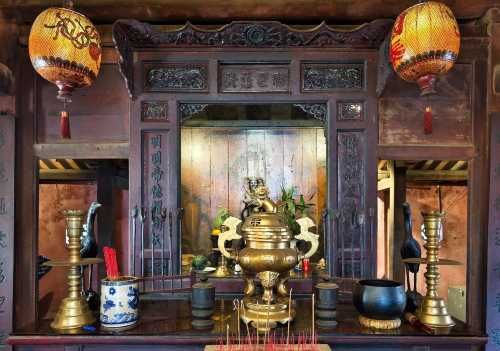Did you know the iconic landmark on Vietnam’s 20,000 dong note is the Japanese Covered Bridge in Hoi An? 🏯✨ Built in the 17th century by Japanese merchants, it symbolizes the blend of Japanese, Chinese, and Vietnamese cultures. Visiting this bridge feels like stepping into the note itself — full of history, charm, and beauty. Don’t miss this must-see spot when exploring the lantern-lit streets of Hoi An! 🇻🇳💛 #HoiAn #Vietnam #Travel
jamesmtlim
Hoi An Ancient Town, Vietnam | Chùa Cầu Bridge: A Century-Old Covered Bridge Where Japanese and Vietnamese Cultures Meet, Quietly Preserving the Ancient City's Prosperity and Transcendence Among the many landmarks of Hoi An Ancient Town, the Chùa Cầu Bridge (Chùa Cầu) stands out. Built in the early 17th century by Japanese immigrants, this wooden bridge is also known as the "Japanese Bridge." It serves not only as a bridge for transportation but also as a symbol of cultural exchange. The bridge is constructed of solid wood and bluestone, with a tiled roof and intricate carvings along its sides. Inside, a porch enshrines the Bac Tai, the God of War, praying for good weather and safe journeys. Walking across the bridge, one feels the weight of history, as if every plank bears the footprints and stories of merchants and travelers. At dusk, lanterns are lit, and the Chùa Cầu Bridge's silhouette is reflected on the river, like a scene frozen in time. Quietly spanning the stream of the ancient town, it has witnessed centuries of prosperity and transformation in Hoi An.
諸文武
Hoi An Ancient Town, Vietnam | Evening Stroll: Encounter the Gentleness of the Ancient City in the Lights of the Alleys As dusk falls, stepping into Hoi An Ancient Town, the atmosphere begins to transform. The bustle of the day gradually fades, and the streets are bathed in golden and orange hues by the setting sun. The ancient walls and mottled wooden windows appear particularly charming in this soft light and shadow. The ancient town is perfect for a stroll at this time. Pedestrians slow their pace, chatting outside lantern-draped shops or strolling quietly along the Thu Bon River. The light of the newly lit lanterns reflects on the river, and a gentle breeze caresses your face, making even time seem to slow down. A stroll in Hoi An is more than just a part of travel; it's a kind of solace. You can capture the street lights with your eyes and feel the centuries-old atmosphere of this ancient city with your heart.
諸文武
Hoi An Ancient Town, Vietnam | Leisurely Moments Before Dusk: Sit Down and Slow Down with the Ancient Town Before night falls, Hoi An Ancient Town offers a distinctly different atmosphere from the bustling atmosphere after the lanterns are lit. The yellow walls reflect the setting sun, and the streets are devoid of the daytime bustle, replaced by a gentle, leisurely atmosphere. Music wafts from the doorways of small shops, and groups of people gather in cafes, chatting or quietly reading. A gentle breeze drifts along the riverbank, and even though the lanterns haven't yet been fully lit, the gentleness of approaching night is already faintly revealed. In this atmosphere, it's tempting to sit down, order a cup of coffee or a refreshing iced coconut drink, and simply enjoy a moment of rest. Everything before you is unplanned, allowing travelers to slow down and experience the authentic atmosphere of the ancient town.
諸文武
Hoi An Ancient Town, Da Nang, Vietnam | The Chùa Cầu Bridge: A Quiet Japanese-Style Bridge, a Witness to Transcendence and Time Among the many historic buildings in Hoi An Ancient Town, the Chùa Cầu (Japanese Covered Bridge) is undoubtedly one of the most iconic landmarks. Built in the 17th century by Japanese merchants, it connects neighborhoods on both sides of the river. For centuries, it has served not only as a vital transportation hub but also as a witness to cultural exchange and historical change. Mostly constructed of wood, the Chùa Cầu Bridge features a tiled roof and intricate carvings. Stone statues of monkeys and dogs guard each end, symbolizing the passage of time. A small shrine dedicated to the North Pole Xuantian God stands in the center of the bridge, symbolizing the protection of the bridge and passersby. During the day, visitors flock to the bridge, and its rustic charm contrasts with the yellow walls and green windows on both sides, imbued with a sense of history. At night, illuminated by lights, the Chùa Cầu Bridge's reflection in the Thu Bon River creates an even more tranquil and romantic scene.
諸文武
Popular Trip Moments
Favorite cafe in Hoi An | Day 4 of the trip | Hoi An Nights✨ | Sunny Vietnam Style🌞 | World Cultural Heritage – Hoi An Ancient Town, Vietnam | 🇻🇳[Hoi An] A place where meticulous care and sincerity reside, Hoi An Sincerity Hotel & Spa | 🌿 Bay Resort Hoi An – Surrounded by tranquility along the river | 🌿taran. – A relaxing lifestyle shop in Hoi An run by a Japanese owner | 🌙 Hội An – A magical night of flickering lights | 🇻🇳[Hoi An] Sunset, a glass of the sea's gift — Afterglow at Ubebe in Hoi An | Hoi An Magic Day✨Chasing colors | 🌿 รีวิว Legacy Hoi An Resort – สวรรค์แห่งความสงบใ | 🇻🇳[Hoi An] The taste of learning found on the main street of Hoi An, NOODLE House by STREETS | Day 3 of my Da Nang trip | Hoi An a perfect cultural heritage | 🇻🇳[Hoi An] Leisure in an open space, a place for Vietnamese people to relax, KAYO COFFEE HOUSE | 🇻🇳[Hoi An] A place where refined taste and leisure linger, Thúng Hội An Restaurant | Heart of Central Vietnam: DaNang and HoiAn 🏮 | 🏮 Hoi An Old Town: A Walk Through Time | 🛶 Hoi An's emotional experience, basket boat | Highly recommend Cozy An Boutique Hotel | Hoi An Heritage Walk🚶 Discovering Japan’s Legacy in Hoi An | Sunny Hoi An Vibes☀️ | Uncle Huan, a Hoi An cafe with a great view of Ba Mu Temple | Faifo coffee, a popular cafe in Hoi An Old Town💛 | Giving away a travel plan for Da Nang and Hoi An for under ten thousand! | Vietnam's UNESCO World Heritage Site, Hoi An Ancient Town | Recommended 4-day trip to Da Nang | BEST value for money vacation in Asia
Recommended Attractions at Popular Destinations
Popular Attractions in Kuala Lumpur | Popular Attractions in Iguazu National Park(Argentina) | Popular Attractions in Walt Disney World Resort | Popular Attractions in Dubai | Popular Attractions in Paris | Popular Attractions in Los Angeles | Popular Attractions in Barcelona | Popular Attractions in Bangkok | Popular Attractions in Rome | Popular Attractions in London | Popular Attractions in Singapore | Popular Attractions in Osaka | Popular Attractions in New York | Popular Attractions in Zanzibar Island | Popular Attractions in Bali | Popular Attractions in Melbourne | Popular Attractions in Beijing | Popular Attractions in Shanghai | Popular Attractions in Sydney | Popular Attractions in Las Vegas | Popular Attractions in Tokyo | Popular Attractions in Chefchaouene | Popular Attractions in Kyoto | Popular Attractions in Phuket | Popular Attractions in West Lake | Popular Attractions in Chengdu | Popular Attractions in Florence | Popular Attractions in Madrid | Popular Attractions in Istanbul | Popular Attractions in Jungfrau Region
Popular Attractions
Emperor Qinshihuang's Mausoleum Site Museum | Huajue Lane, the Great Mosque | Shaanxi History Museum | Qinglong Temple | West Park | Puji Temple | Putuoshan Duobao Tower | Yang Guan | Mingsha Mountain And Crescent Spring | Yumen Pass | Fayu Temple | Huiji Temple | Tiananmen Square | The Palace Museum | Nanjing Andover Under Water World | Xiaomeisha Resort | Riyue Bay | Nanyan Bay | Baisha Uprising Memorial Park | Melaka Butterfly & Reptile Sanctuary (Taman Rama-rama & Reptilia Melaka) | Sector 27 Park | Stade | St. Lawrence Miner's Memorial Museum and Lunch Tin Cafe" | Park 20 | Masjid Al-Huda | Southside Park Trail Trailhead | Sai Baba Temple Balkhadi Khadaki khurd | Omemee Dam | Ban Ba Lu Ka Mosque | Venkateswara Temple
Popular Restaurants in Hoi An
Madam Khanh - The Banh Mi Queen | White Rose Restaurant | Com Linh - Vietnamese Restaurant | Miss Ly Cafe | Cong Caphe (Hoi An) | Silent Garden Restaurant | Minh Hien Vegetarian Restaurant | Faifo Coffee | The Cargo Club | Viettown- Hoi An | An Bang Beach Village Restaurant | Golden Lotus | Nu Eatery | Jack's Cat Cafe | The Temple Restaurant & Lounge | TIA Coffee & Restaurant | Restaurant HAVANA | Morning Glory Signature | Havana Bar & Restaurant | Vy’s Market Restaurant & Cooking School | Otta Cuisine | Nostalife | Trung Bac Restaurant | Lantern Town restaurant | Vinh Hung Restaurant | Vegan Zone Hoi An | Rice Drum | Cay Me | AN GIA cottage | Hoi An Burgers Plus
Popular Ranked Lists
Popular Luxury Hotels in Frankfurt | Popular Premium Hotels in Emboodhu Finolhu | Popular Best Things to Do in Taipei | Popular Luxury Hotels in Mamanuca Islands | Top 50 Best Things to Do in Hanoi | Top 50 Must-Visit Restaurants in Bangkok | Top 50 Best Things to Do in Barcelona | Top 10 Best Things to Do in Kamakura | Popular Premium Hotels in Hsinchu | Top 10 Best Things to Do in Kathmandu | Popular Premium Hotels in New Taipei City | Top 50 Best Things to Do in Seogwipo | Popular Luxury Hotels in Central Java | Popular Best Things to Do in Vladivostok | Popular Luxury Hotels in Warsaw | Top 50 Must-Visit Restaurants in Fukuoka | Top 20 Luxury Hotels in Madrid | Top 50 Best Things to Do in Rome | Top 50 Best Things to Do in Budapest | Top 50 Must-Visit Restaurants in Taipei | Top 50 Best Things to Do in Edinburgh | Top 50 Must-Visit Restaurants in Osaka | Popular Best Things to Do in Boracay Island | Top 10 Luxury Hotels in Venice | Top 50 Must-Visit Restaurants in Chengdu | Top 10 Luxury Hotels in Zhuhai | Top 10 Luxury Hotels in Amsterdam | Top 20 Best Things to Do in Kota Kinabalu | Popular Luxury Hotels Near Kang County | Top 50 Must-Visit Restaurants in Milan
About
Payment methods
Our partners
Copyright © 2025 Trip.com Travel Singapore Pte. Ltd. All rights reserved
Site Operator: Trip.com Travel Singapore Pte. Ltd.
Site Operator: Trip.com Travel Singapore Pte. Ltd.
























